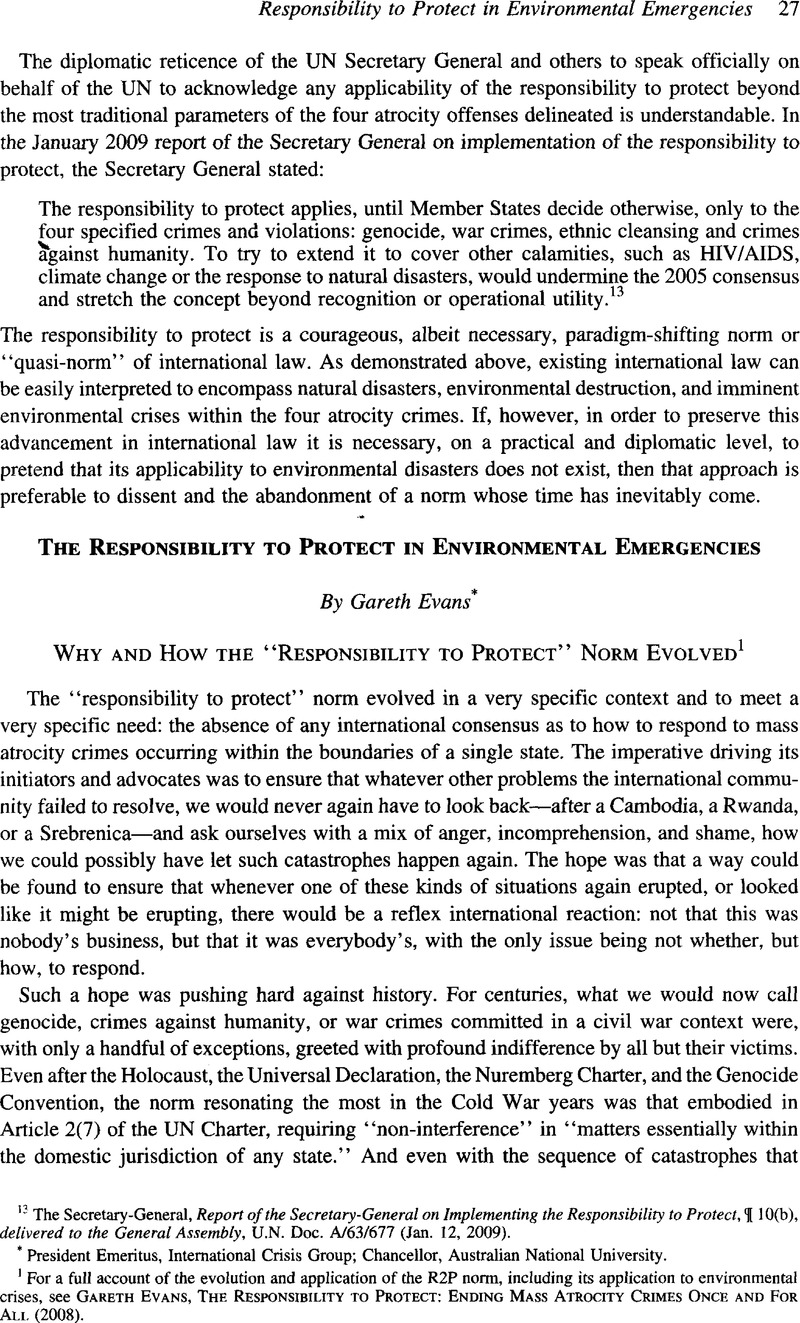Published online by Cambridge University Press: 28 February 2017

1 For a full account of the evolution and application of the R2P norm, including its application to environmental crises, see Gareth Evans, The Responsibility to Protect: Ending Mass Atrocity Crimes Once and for All (2008).
2 The Secretary-General, Report on Implementing the Responsibility to Protect, U.N. Doc. A/63/677 (Jan. 12,2009).
3 For Kouchner’s widely reported statement see, for example, Darren Schuettler, Myanmar Must Act Now to Clear Aid Red Tape, Reuters, May 7, 2008, available at www.reuters.com/article/featuredCrisis/idUsbkk328448. For some of the reaction it engendered, see Mydans, Seth, Myanmar Faces Pressure to Allow Major Aid Effort, N.Y. Times, May 8, 2008 Google Scholar; Charbonneau, Louis, China, Indonesia Reject France’s Myanmar Push, Reuters, May 8, 2008 Google Scholar; Blitz, James, Western Diplomats Assess Risks of Unilateral Intervention, Financial Times, May 10, 2008 Google Scholar; and Farley, Maggie, U.N. Struggles over how to Help Nations that Reject Aid, L.A. Times, May 14, 2008 Google Scholar.
4 Rome Statute of the International Criminal Court, U.N. Doc. A/Conf.183/9 (July 17, 1998), entered into force July 1,2002, art. 7(1), available at www.icc-cpi.int/Nr/rdonlyres/Ea9Aeff7-5752-4F84-Be94-0A655Eb30E16/0/Rome_Statute_English.pdf.
5 Id. art. 7(2)(b).
6 Id. art. 30(2)(b).
7 Glanville Williams, The Mental Element in Crime 55 (1965).
8 “A person acts recklessly with respect to a material element of an offense when he consciously disregards a substantial and unjustifiable risk that the material element exists or will result from his conduct. The risk must be of such a nature and degree that, considering the nature and purpose of the actor’s conduct and the circumstances known to him, its disregard involves culpability of a high degree.” Model Penal Code § 2.02(2)(c) (1985).
9 ICISS, The Responsibility to Protect XII, 35-37 (2001); UN, High-Level Panel on Threats, Challenges, and Change, A More Secure World: Our Shared Responsibility 66-67, 106-07 (2004); Kofi Annan, in Larger Freedom: Towards Development, Security and Human Rights for All 43, 83, U.N. Doc. A/59/2005 (2005).
10 See further my response to Bernard Kouchner’s initial statement, circulated widely in the UN and subsequently published as Gareth Evans, Facing Up to Our Responsibilities, The Guardian, May 12, 2008, which appeared to have some influence in steering the R2P debate back along these lines.
11 See, for example, To Protect Sovereignty, or Protect Lives?, The Economist, May 15, 2008; Timothy Garton Ash, We Have a Responsibility to Protect the People of Burma. But How?, The Guardian May 22, 2008; Ramesh Thakur, Getting Real with R2P, Daily Times (Lahore) May 28, 2008; David Rieff, Humanitarian Vanities, N.Y. Times Magazine, June 1, 2008, at 13. For some other commentary see the materials collected at the Responsibility to Protect—Engaging Civil Society (R2PCS) website, available at www.responsibilitytoprotect.org/index.php/latest_news/1686.
12 Axworthy, Lloyd and Rock, Allan, R2P: A New and Unfinished Agenda, in Global Responsibility to Protect 1, 64 (2009)Google Scholar.